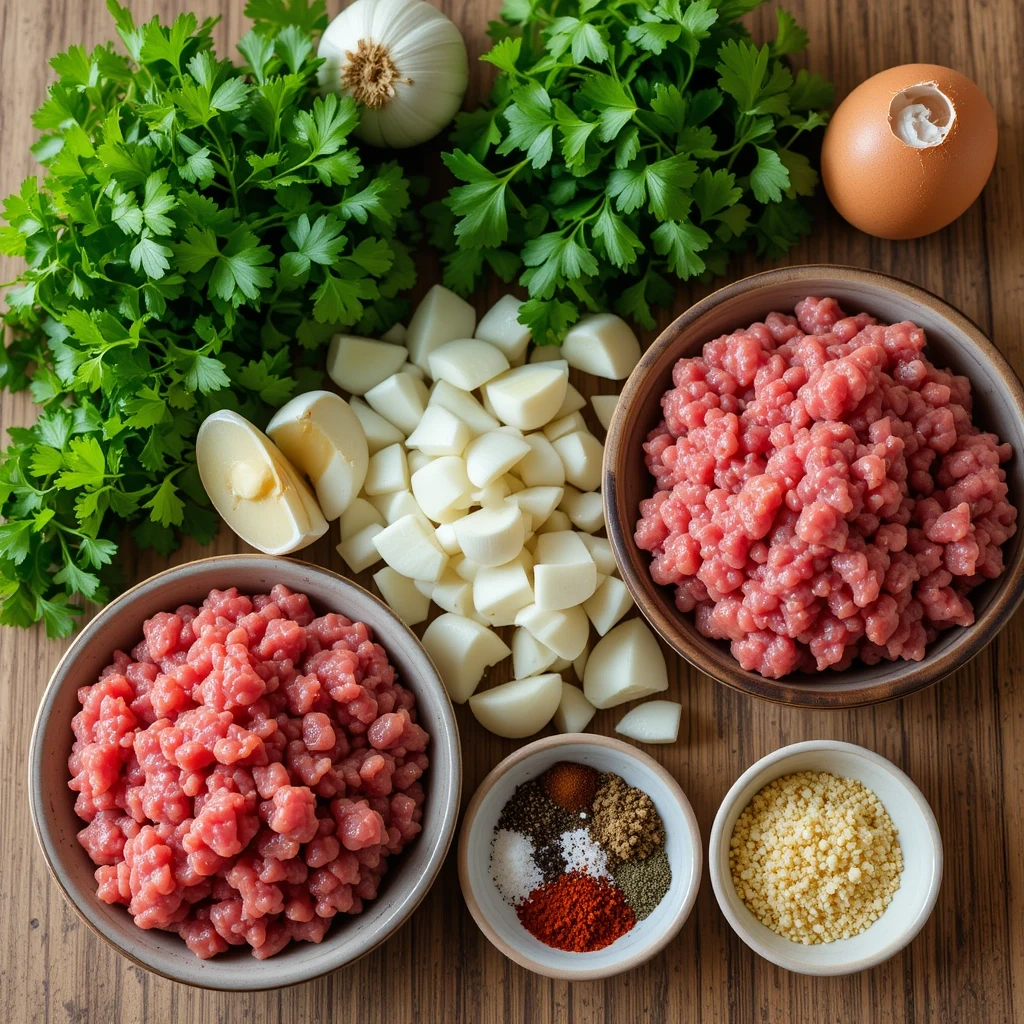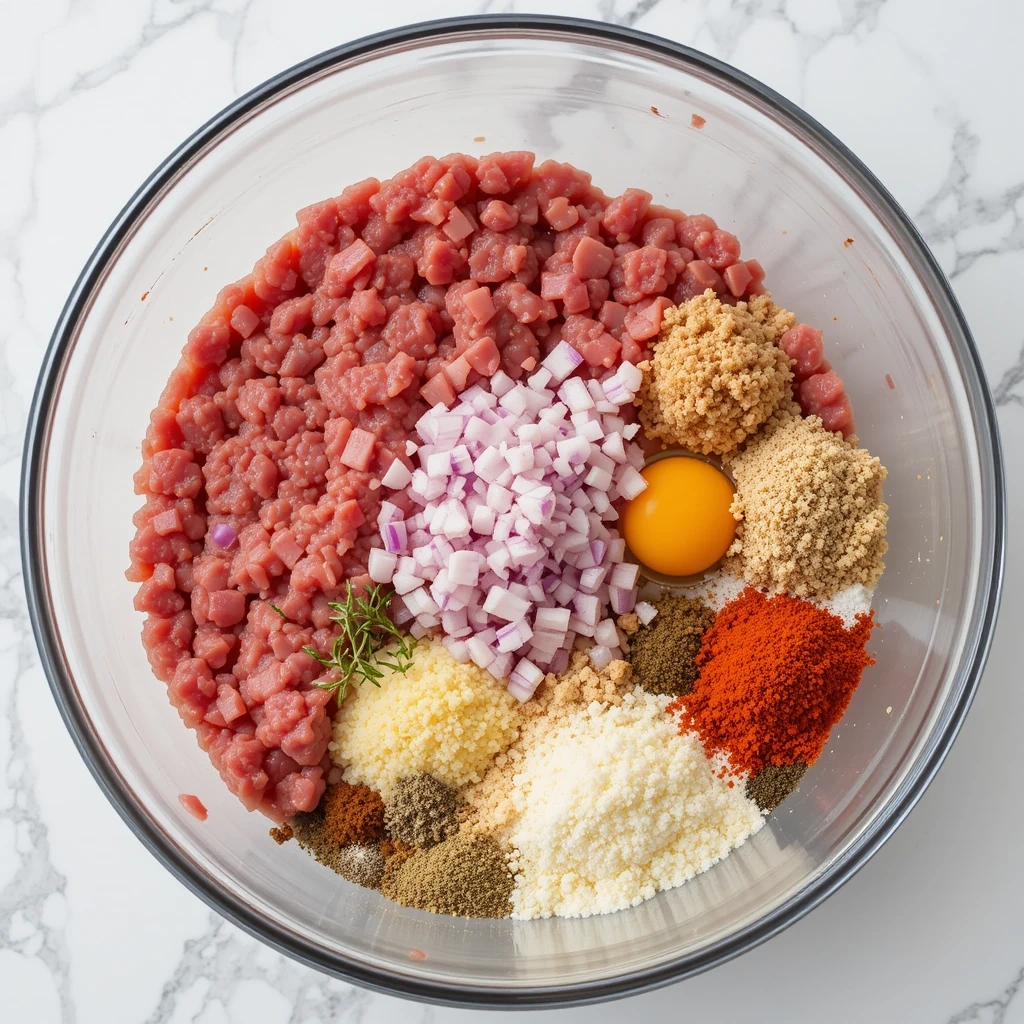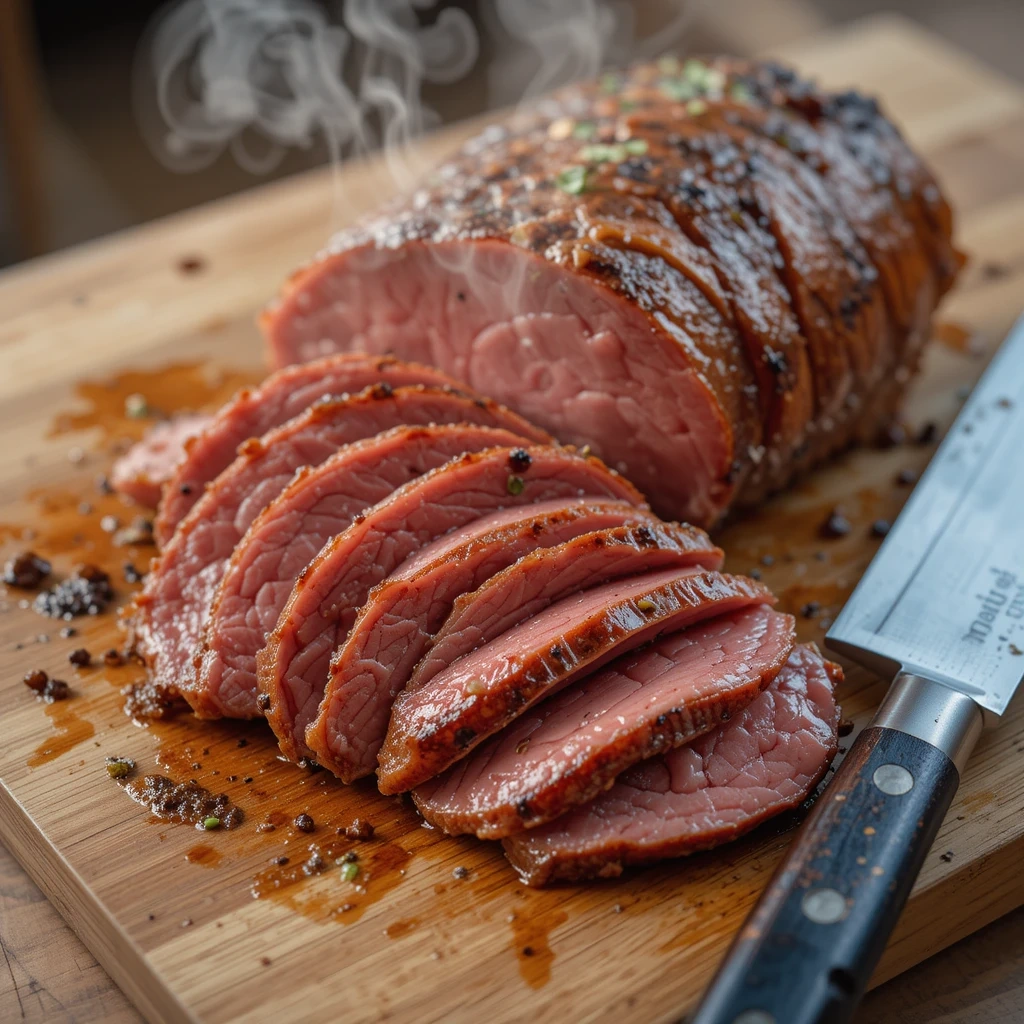Gyro meat is a beloved staple of Greek cuisine, known for its savory aroma, tender texture, and rich blend of spices. Traditionally made from lamb, beef, or a combination of both, gyro meat is seasoned with herbs like oregano, garlic, and onion, then cooked to perfection before being thinly sliced and served in pita bread with fresh vegetables and tangy tzatziki sauce. Making gyro meat at home allows you to customize the flavors to your liking and enjoy an authentic Mediterranean experience right in your kitchen. This introduction to a homemade gyro meat recipe will guide you through the essential ingredients, preparation steps, and tips to help you recreate the delicious taste of Greece with ease and confidence.
When I first tasted gyro meat during a summer trip to Greece, I was instantly captivated by its savory aroma and tender texture. The way the spices danced on my palate was nothing short of magical. I remember sitting at a small taverna, the sun setting behind the ancient ruins, and savoring every bite of that delicious wrap filled with juicy meat, fresh vegetables, and tangy tzatziki sauce.
It was a culinary experience that stayed with me long after I returned home. Since then, I’ve made it my mission to recreate that unforgettable flavor in my own kitchen. Gyro meat, traditionally made from lamb, beef, or chicken, is a staple of Greek cuisine.
The beauty of making it at home is that you can customize the flavors to suit your taste. Whether you prefer a classic approach or want to experiment with different spices, the possibilities are endless. In this guide, I’ll share my favorite homemade gyro meat recipe, along with tips and tricks to help you achieve that authentic taste right in your own kitchen.
Table of Contents
Ingredients for Homemade Gyro Meat
The Meat Mixture
For my recipe, I typically use a combination of ground lamb and beef. The lamb adds richness, while the beef provides a nice balance.
Aromatics and Spices
You’ll also need garlic, onion, and a blend of spices like oregano, cumin, and paprika. I remember the first time I gathered these ingredients; the aroma of fresh garlic and spices filled my kitchen, instantly transporting me back to that little taverna in Greece.
Binding Agents and Fresh Herbs
In addition to the meat and spices, don’t forget about the binding agents! A bit of breadcrumbs and an egg help hold everything together, ensuring that your gyro meat maintains its shape while cooking. Fresh herbs like parsley or mint can also elevate the flavor profile. I often find myself experimenting with different herbs based on what I have on hand, and it’s always exciting to discover new combinations that work well together.

Step-by-Step Instructions for Making Gyro Meat
Preparing gyro meat at home is simpler than you may imagine! Begin by setting your oven to 350°F (175°C).In a large mixing bowl, combine your ground lamb and beef with finely chopped onion, minced garlic, breadcrumbs, egg, and your chosen spices.
I remember the first time I mixed everything together; it felt like a culinary adventure as I got my hands in there, feeling the textures blend into a cohesive mixture. Once everything is well combined, shape the mixture into a loaf or press it into a loaf pan for even cooking. Put it in the oven and allow it to bake for approximately an hour.
The aroma wafting through my home during this time is something I look forward to every time I make gyro meat. After baking, let it rest for a few minutes before slicing it thinly. This resting period is crucial; it allows the juices to redistribute throughout the meat, guaranteeing that every bite is both flavorful and moist.
Looking to add a new cut of beef to your cooking routine? Learn all about beef bavette on Veibrant Recipes! This flavorful, tender cut is perfect for grilling, pan-searing, or roasting — and it’s easier to cook than you might think. Find out how to prepare it perfectly and bring a bold, juicy dish to your table.
Explore the full guide here:
https://veibrantrecipes.com/beef-bavette/

Tips for Perfecting Homemade Gyro Meat
| Tip | Description |
|---|---|
| Use a combination of meats | Combine ground lamb and ground beef for a more flavorful gyro meat. |
| Season generously | Use a variety of spices such as oregano, garlic, onion, paprika, and cumin to season the meat. |
| Let the meat marinate | Allow the seasoned meat to marinate for at least 2 hours, or better yet, leave it overnight to boost the flavors. |
| Use a food processor | Pulse the meat mixture in a food processor to achieve a fine texture, similar to the traditional gyro meat. |
| Bake or grill the meat | Cook the gyro meat in the oven or on a grill for an authentic taste and texture. |
| Slice thinly | After cooking, slice the gyro meat thinly for the perfect gyro sandwich or platter. |
One of the most important tips I can share is to not rush the process. Allowing the meat mixture to chill in the refrigerator for at least an hour before baking can significantly enhance the texture and flavor. This step helps the flavors meld together beautifully and makes it easier to slice once cooked.
I learned this lesson the hard way when I skipped this step once and ended up with crumbly gyro meat that didn’t hold its shape. Another tip is to use a meat thermometer to ensure your gyro meat is cooked perfectly. Aim for an internal temperature of 160°F (70°C) for ground meats.
This not only guarantees safety but also helps you avoid overcooking, which can lead to dry meat. I remember feeling proud when I finally invested in a good meat thermometer; it has made all the difference in my cooking adventures.

Serving Suggestions for Gyro Meat
Once your homemade gyro meat is ready, it’s time to serve it up! One of my favorite ways to enjoy gyro meat is in a warm pita wrap filled with fresh vegetables like lettuce, tomatoes, and cucumbers. Drizzling some homemade tzatziki sauce over the top adds a refreshing touch that complements the savory meat perfectly.
I often host friends for dinner, and watching their faces light up as they take their first bite is one of my greatest joys. For a more substantial meal, consider serving gyro meat alongside roasted potatoes or a Greek salad. The combination of flavors creates a delightful dining experience that transports you straight to the Mediterranean.
On one occasion, I prepared a full Greek feast for my family, complete with homemade baklava for dessert. It was a night filled with laughter and delicious food that we still talk about today.
Want to make restaurant-quality gyros at home? Check out this Traditional Gyro Meat recipe on AllRecipes! It’s packed with authentic Greek flavors and shows you exactly how to create that tender, savory meat that makes gyros so irresistible. Perfect for sandwiches, platters, or a fun family dinner night!
Get the full recipe here:
https://www.allrecipes.com/recipe/173420/traditional-gyro-meat/
Variations and Flavor Enhancements for Gyro Meat
While traditional gyro meat is delicious on its own, there are countless ways to enhance its flavor or switch things up! For instance, adding a touch of smoked paprika can give your gyro meat a subtle smokiness that elevates the dish. I once experimented with adding some chili flakes for a spicy kick, which turned out to be a hit at my last dinner party.
If you’re feeling adventurous, try incorporating different meats or even plant-based alternatives! Ground turkey or chicken can be great substitutes if you’re looking for something lighter. On one occasion, I made a vegetarian version using lentils and chickpeas; while it was different from traditional gyro meat, it was equally satisfying and packed with flavor.
Health Benefits of Homemade Gyro Meat
One of the best parts about making gyro meat at home is knowing exactly what goes into it. Unlike store-bought options that may contain preservatives or fillers, homemade gyro meat allows you to control the ingredients and make healthier choices. Using lean cuts of meat can reduce fat content while still providing essential protein.
I’ve found that when I prepare meals from scratch, not only do they taste better, but they also make me feel better knowing they’re wholesome. Additionally, incorporating fresh herbs and vegetables into your gyro wraps boosts their nutritional value significantly. Fresh veggies add fiber and vitamins while enhancing flavor without extra calories.
I often find myself sneaking in extra greens when serving gyro wraps; it’s an easy way to make my meals more nutritious without sacrificing taste.
5 Common Mistakes to Avoid and Their Solutions
As with any recipe, there are common pitfalls when making homemade gyro meat that can lead to less-than-ideal results. One mistake I made early on was not seasoning enough; under-seasoned meat can result in bland flavors. To avoid this, always taste your mixture before cooking—don’t be afraid to adjust spices as needed!
Another common issue is overcooking the meat, which can lead to dryness. To combat this, use a meat thermometer as mentioned earlier; it’s an invaluable tool in ensuring perfectly cooked gyro meat every time. Additionally, be mindful of how thinly you slice your meat after cooking; thicker slices can be chewy rather than tender.
Lastly, don’t forget about resting time! Cutting into your gyro meat too soon can cause juices to run out, leaving you with dry slices. Allowing it to rest for at least five minutes will yield juicier results.
Trust me; this small step makes all the difference in achieving that perfect bite every time!
FAQs
What is gyro meat?
Gyro meat is a traditional Greek dish made from ground meat, typically lamb, beef, or a combination of the two. The meat is seasoned with a variety of herbs and spices, then cooked on a vertical rotisserie. Once cooked, the meat is thinly sliced and served in pita bread with toppings and sauces.
What are the ingredients for homemade gyro meat?
The ingredients for homemade gyro meat typically include ground lamb or beef, onion, garlic, oregano, thyme, marjoram, rosemary, salt, pepper, and sometimes additional spices like cumin or paprika.
What are the step-by-step instructions for making gyro meat?
The step-by-step instructions for making gyro meat involve mixing the ground meat with the seasonings, shaping it into a loaf, and then cooking it on a vertical rotisserie or in the oven. Once cooked, the meat is thinly sliced and served.
What are some tips for perfecting homemade gyro meat?
Some tips for perfecting homemade gyro meat include using a combination of ground lamb and beef for a more complex flavor, ensuring the meat is well-seasoned, and cooking it until It has a crunchy outer layer while the inside stays tender.
How is gyro meat typically served?
Gyro meat is typically served in pita bread with toppings such as tomatoes, onions, and tzatziki sauce. It can also be served on a platter with rice, salad, and pita bread on the side.
What are some variations and flavor enhancements for gyro meat?
Some variations and flavor enhancements for gyro meat include adding different herbs and spices to the meat mixture, marinating the meat before cooking, or using different types of meat such as chicken or pork.
What are the health benefits of homemade gyro meat?
Homemade gyro meat can be a good source of protein and essential nutrients, depending on the type of meat used. It can also be a flavorful and satisfying option for those following a low-carb or keto diet.
What are 5 common mistakes to avoid when making gyro meat and their solutions?
Some common mistakes to avoid when making gyro meat include not seasoning the meat enough, overcooking the meat, using meat that is too lean, not allowing the meat to rest before slicing, and slicing the meat too thick. Solutions include adjusting the seasoning to taste, monitoring the cooking time closely, using a combination of lean and fatty meat, allowing the meat to rest before slicing, and slicing the meat thinly for the best texture.

gyro meat recipe
Ingredients
- 500 g ground lamb
- 500 g ground beef
- 1 medium onion finely chopped
- 3 cloves garlic minced
- 2 teaspoons dried oregano
- 1 teaspoon ground cumin
- 1 teaspoon paprika
- 1 teaspoon salt
- ½ teaspoon black pepper
- ½ cup breadcrumbs
- 1 large egg
- 2 tablespoons fresh parsley or mint chopped (optional)
- Pros
- Authentic Greek flavor at home
- Customizable with different meats and herbs
- No preservatives or fillers
- High in protein
- Great for family meals or gatherings
- Cons
- Requires both lamb and beef for best flavor may not suit all diets
- Needs time to chill and rest for best results
- Not suitable for vegetarians/vegans unless adapted
Instructions
- Preheat oven to 350°F (175°C).
- In a large mixing bowl, combine ground lamb, ground beef, chopped onion, minced garlic, breadcrumbs, egg, oregano, cumin, paprika, salt, black pepper, and fresh herbs (if using).
- Mix thoroughly by hand or with a food processor until the mixture is cohesive and smooth.
- Shape the mixture into a loaf and place it in a loaf pan (or shape freeform on a baking sheet).
- (Optional) Chill the mixture in the refrigerator for at least 1 hour for better texture and flavor.
- Bake for 1 hour, or until the internal temperature reaches 160°F (70°C).
- Remove from oven and let the gyro meat rest for at least 5 minutes before slicing thinly.
- Serve in warm pita bread with tzatziki sauce, tomatoes, onions, lettuce, or as desired.

